Double tunnel vision
March 14, 2012

The famed tunnels on Kanan Dume Road, including the ones known as T3, above, are getting new liners.
It just might be the biggest production to hit the tunnels of Kanan Dume Road since 1,000 extras turned out for the 1998 action flick “Deep Impact.”
Two sets of tunnels on the famed, twisting road through the canyons above Malibu are about to get a multimillion dollar makeover.
The Board of Supervisors this week approved plans to install steel liners in the tunnels at an estimated construction cost of between $7 million and $9.5 million. When related services such as planning, testing, consulting and surveying are included, the project’s total cost is expected to be about $11.1 million, the Department of Public Works said in a letter to supervisors.
The reinforcement is needed to deal with decades-old gunite lining and steel ribbing that are beginning to show their age.
“We did some inspections and found that some of the existing liner was coming down,” said Lance Grindle, assistant head of Public Works’ Design Division. “I don’t think anybody got hit, but the potential was there.” Another problem: water seeps into the tunnels in rainy weather. A new drainage system will be installed as part of the project.
Kanan Dume Road was dedicated in 1968, and at least two of its tunnels were in service by the following year. But completing the entire stretch from the Ventura Freeway to the Pacific Coast Highway was a long-running project. A 1965 Road Department memo said the highway (then known as Dume Canyon) was half-finished and would take six more years of inmate labor from the county’s now-defunct Detention Camps to complete the final six miles. (The same memo noted that the county got 70% of the right of way “gratis.” The rest of the land was valued at around $140,000.)
The work crews were followed by Hollywood crews, attracted by the look of tunnels set into craggy stone on a dramatic stretch of quintessential California roadway running from Agoura Hills to Malibu.
Over the years, perhaps you’ve caught the tunnels’ work in Chrysler or Mitsubishi commercials, or in movies like “Charlie’s Angels: Full Throttle.”
But their biggest star turn came in the final scenes of “Deep Impact,” in which they doubled as an Ark-like cave for residents of Planet Earth hunkering down in hopes of surviving a massive comet strike.
The two-day shoot included not just 1,000 human extras but also “lions, jaguars, hyenas, alligators, pythons, kangaroos, ostrich, buffalo, camels, elephants, zebras, cattle, chickens [and] birds,” according to the Film Scouts website.
Location scouts seeking to book the tunnels for upcoming appearances will need to work fast (as well as overcome a lot of county restrictions on vehicle size and weight.) The liner replacement work on the Kanan Dume tunnels known as T2 and T3 is expected to begin in September and conclude in August, 2013. After that, a separate project will target another pair of Kanan Dume tunnels, known as T1, as well as a single-barreled tunnel on Malibu Canyon Road.
For the Kanan Dume tunnels, work will take place on one side at a time, while the other side will temporarily be used for two-way traffic. Plans for handling traffic on Malibu Canyon during the eventual tunnel work there are still being developed to ensure that emergency vehicles will be able to get through and to determine whether some or all the work could take place at night.
The county had initially asked for bids on the tunnel work last year. But the original solicitation had to be amended several times, and when the bids came in, each of the four lowest bids had “some level of discrepancy, clerical error, omission, vagueness or mistake,” the Public Works letter said.
The new bids will be opened on April 10.
Posted 3/14/12
A degree of security
March 14, 2012

Homeland security and emergency response is a growing field. Above, a helicopter in Texas after Hurricane Rita.
When times get tough, the smart get learning.
Rising to meet evolving labor needs, UCLA Extension is offering a new Homeland Security and Emergency Management Certificate. You can find out more at an open house on Tuesday, March 20.
The nine-month continuing education program to obtain the certificate is aimed at current professionals in management and supervisory positions. Registration for the program has already begun, and the first classes start April 3.
Demand for professionals trained in homeland security and emergency management has increased over the past few years, according to the United States Bureau of Labor. Over the next few years, the bureau predicts further job growth in the sector. Recent events like the 2011 Japan earthquake and tsunami have increased awareness of a critical need for experts in handling emergency situations.
A series of workshops at the 5:30 p.m. open house will provide further details of the new program and others offered by UCLA Extension. Those interested can register online for the workshops that will be held at the school’s Figueroa Courtyard facilities, 261 South Figueroa Street. Prospective students who register for classes at the event will get a 10% discount off spring courses.
Posted 3/14/12
The Rock by the numbers
March 13, 2012

When it comes to the megalith's mega-transport, it was a matter of gallons per mile, not miles per gallon.
You knew the spectacle would be big when the “Levitated Mass” rock set out for LACMA. But how big? Glad you asked:
- Height of boulder: 21 feet, 6 inches
- Weight of the boulder: 340 tons
- Weight of the largest granite slab in the Great Pyramid: 80 tons
- Length of the transport: 299 feet
- Length of a football field: 300 feet
- Width of the transport: 27 feet
- Width of a lane on the 405: 12 feet
- Nights in transit: 11
- Miles traveled: 105
- Top speed: 5 mph
- Total gallons of diesel fuel burned: 2,250
- Gallons of diesel fuel to move one mile: 5
- Distance per gallon: 1,056 feet
- Miles walked beside the boulder by Emmert crewman Joe Schofield: 75
- Blistered toes on Joe Schoefield’s feet: 3
- Counties traversed: 4
- Cities traversed: 22
- Crowd estimate at Jurupa Valley launch point: 300
- Crowd estimate at Long Beach’s “Rock-a-pa-looza” Rock Party: 20,000
- Crowd estimate along Wilshire Boulevard between midnight and 4:30 a.m. for the Rock’s arrival at LACMA: 1,000+
- Cups of coffee sold after midnight at the Patina coffee cart outside LACMA: 175
- Emmert International heavy haul crew: 25
- Cable lines moved just by Time Warner Cable crews: 90+
- Traffic signals moved or removed and replaced on one night between Long Beach and Carson: 41 poles and 12 signal arms
- Port-A-Potties in the convoy: 1. Times cleaned in 11 nights: 5
- Marriage proposals next to the Rock: 1
- Attempts to crawl under the Rock by members of the public: 1
- Free bookmarks handed out at Rock stops by LACMA: 110,000
- Consecutive hours deejays played songs with words “rock” or “stone” in the title: 5
- Tacos sold at Patricia’s Mexican Restaurant across from the Rock on Wednesday: 4,000. Tacos sold at Patricia’s on a normal weekday: 300
- Number of cars towed on Wilshire to make way for the Rock’s arrival at LACMA: 10
- Fine and towing fees for parking in the temporary no parking zone: $354.50
- Towed Hondas: 6
- Towed Mercedeses: 1
- Time The Rock was delayed because of illegally parked cars: 1 hour, 33 minutes
- Complaints to towing firms from car owners who didn’t see temporary “No Parking” signs on Wilshire: 2
- Hits on LACMA’s Google map of the transport route: 1,043,800
- New followers to LACMA’s Twitter account: About 4,000
- Views on LACMA’s YouTube video of the transport: 26,888+
- Axles on the transporter: 44
- Tires on the transporter: 176
- Flat tires during the trip: 0
- Pre-emptive tire changes: 1
- Time spent turning the first corner in Jurupa Valley: 1 hour, 8 minutes
- Steepest grade in Chino Hills: 10%
- Tightest clearance: 6 inches in Long Beach
- Lost palm trees: 2
- Estimated transportation cost, including utility line clearance: $4.5 million
- Estimated total cost of the project: $10 million
- Estimated cost to taxpayers: $0
- Time it took to build and load the Rock’s transport: 2 months
- Estimated time to dismantle it: 5-6 days
- Length of the concrete Slot that is the other half of “Levitated Mass”: 456 feet
- Depth of The Slot foundation: 3 feet
- Cubic yards of concrete in the slot: 2,000
- Height The Rock will hover above viewers when “Levitated Mass” is finished: 15 feet
Sources: LACMA, Caltrans, Emmert International, Office of Long Beach City Councilman James Johnson, Ramon Vasquez III, Time Warner Cable, Los Angeles Signal Construction Co., Patricia’s Mexican Restaurant, Patina Catering, S&J Wilshire Tow, Joe Schofield, Buro Happold, Matt Construction
- Posted 3/13/12
LACMA’s traveling rock show
March 13, 2012
It was a journey for the ages—all ages: a slow-moving procession through 22 cities and four counties, beginning in a Riverside County quarry on Tuesday, February 28, and culminating at the Los Angeles County Museum of Art on Saturday, March 10. Along the way, thousands of spectators turned out to marvel at artist Michael Heizer’s 340-ton boulder and its massive custom-made transport. At the museum, the rock will be attached to a concrete channel, creating the illusion that it’s floating, or levitating, overhead. “Levitated Mass” is expected to open as a permanent LACMA installation in late spring or early summer. Here’s our video account of one of the most memorable moments in L.A.’s art history.

Have you met Tia Chucha?
March 13, 2012
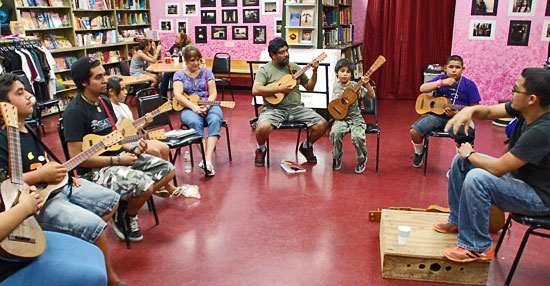
Students at Tía Chucha’s learn to play the jarana, a folk instrument popular in the Veracruz region of Mexico.
If you’re seeking robust, homegrown cultural experience in the San Fernando Valley, Tía Chucha’s is a good place to start. This Saturday, March 17, the cultural center and bookstore holds its 11th anniversary celebration.
The event kicks off with ceremonial music and dance by Temachtia Quetzalcoatl, followed by poetry readings, a Womyn’s Art Exhibit, hip-hop dance from The Gr818ers, a puppet show from the Youth Speak! Collective and music from Sueños Dorados and members of El Vuh. There will also be kids’ activities and food vendors on hand.
Tía Chucha’s is a nonprofit organization with a goal of fostering cultural revival in the Northeast San Fernando Valley by providing a forum for visual arts, dance, music, theater, writing and literacy. Its independent bookstore publishes cross-cultural artists from across the country. Chicano author Luis J. Rodriguez co-founded Tía Chucha’s, naming it after a lively and multitalented aunt who inspired him.
The free anniversary celebration takes place Saturday, March 17, from 1 p.m. to 6 p.m. at 13197-A Gladstone Avenue in Sylmar. And it’s not too early to start thinking about being a volunteer for Tía Chucha’s annual “Celebrating Words” festival, coming May 19.
Posted 3/13/12
Meeting to get the 411 on the 405
March 13, 2012
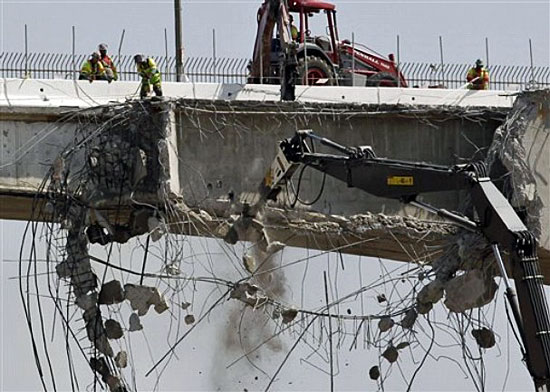
Stay up to speed on the 405 Project at an upcoming community meeting. Above: Mulholland Bridge comes down.
It’s a busy time on the I-405 Sepulveda Pass Improvements Project, with lots going on at many locations. Here’s a chance to find out the latest. On Thursday, March 22, Metro staff will discuss the project’s progress and provide information about upcoming construction activities at the first of five community meetings.
You can find out what’s happening with the Sunset Boulevard,Mulholland Drive and Skirball Center Drive bridges. Information about the upcoming Wilshire Boulevard ramp closures—including detours, signage and schedules—also will be provided. And you can find out more about the December, 2011 collapse of a so-called “mechanically supporting engineering” retaining wall, and learn why all such walls on the project are being rebuilt. A question-and-answer session will follow the 45-minute presentation.
The March 22 meeting will be held from 6 p.m. to 8 p.m. at the Westwood Recreation Center, 1350 South Sepulveda Boulevard. More upcoming meetings are scheduled for May 24, July 26, September 27 and November 15 at locations to be determined. Visit Metro’s I-405 project webpage for more details, including upcoming detours and lane closures.
When it’s completed, the I-405 project will expand capacity on one of the most heavily traveled, congested freeways in the country by adding an HOV lane, widening existing ramps and bridges, and improving the supporting infrastructure. It’s expected to be finished in 2013.
Posted 3/13/12
The Rock is a wrap—for now
March 10, 2012
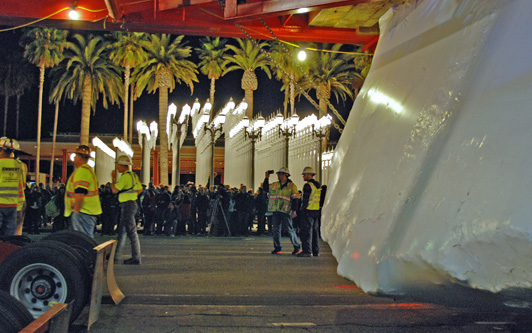
After its 4:30 a.m arrival, The Rock was parked for a photo-op in front of Chris Burden's iconic "Urban Light."
As crowds cheered and a loudspeaker blared Queen’s “We Will Rock You,” the Rock rolled into the Los Angeles County Museum of Art just before dawn on Saturday morning, riding down Wilshire Boulevard in its massive red transport like a 340-ton beauty in the Rose Parade.
“Fantastic,” said LACMA Director Michael Govan, unable to stop smiling as the focal point of “Levitated Mass,” the museum’s latest permanent installation, paused in front of the museum.
“Yahoo!” applauded Govan’s 7-year-old daughter, who was dressed in a pink coat and hoisted high on his shoulders.
“Magnificent!” breathed Alexandra Thum, a West Hollywood product designer who had worked her way through the crowd to get a curbside view. “It’s just so great to be here and see all the community together.” Around them, several hundred onlookers cried “Bravo! Bravo!” under the antique street lamps of another iconic LACMA masterpiece, Chris Burden’s “Urban Light.”
The reception capped an 11-day trip across 22 cities and four counties for the boulder, a hunk of granite the size of a 2-story teardrop that, in the weeks ahead, will be affixed atop a concrete channel, creating the illusion that it is levitating overhead. The work by Nevada earth artist Michael Heizer is scheduled to open in spring or early summer. (The famously reclusive artist was not on hand Saturday, but is expected to be in Los Angeles for the piece’s assembly.)
Although The Rock, as it came to be known, is only one component in the installation, it instantly became a media event itself because of the novelty and engineering involved in its move from its Jurupa Valley quarry in Riverside County.
Progressing at a stately 5 miles per hour and parked by day to minimize traffic disruptions, it inspired a marriage proposal in Glen Avon and a citywide block party in Long Beach, gawker’s block in Diamond Bar and pajama-clad sightseers near Expositon Park. In Rowland Heights, an accountant came home to discover it outside his bedroom window. So many people posed next to it for photos that, perhaps inevitably, it became an Internet meme for a digital moment.
While many thrilled at the spectacle, some decried its estimated $10-million expense, which has been covered entirely by private donors. “I think they should have spent $10 million on art programs instead of this rock,” said Patrick Taylor, a security guard and father of two who lives near Exposition Park.
Overall, however, museum officials were pleasantly surprised at the public reaction, which included a wave of fresh awareness for LACMA.
“When this started, I thought it would be much more controversial,” said Govan. “You know, ‘Is it art? Is it not art?’ But people mostly have just been fascinated and appreciative. And so many have learned about the museum from this experience.”
On Friday night—or, more accurately, Saturday morning—that appreciation was out in full, only-in-L.A. glory as thousands pulled all-nighters for the last leg of The Rock’s journey, up Western Avenue and along Wilshire Boulevard’s famed Miracle Mile.
Onlookers on foot and on bicycle snapped photos and videos and narrated the boulder’s slow-speed progress on hundreds of cell phones. Dogs barked. Tourists jumped out of buses and cabs to investigate the commotion.
A tall man dressed as Jesus and a shorter person dressed as a unicorn posed for pictures. Comedians worked the crowd. (“Have you seen my dog? It’s a ROCK-weiler!”) Further back in the crowd, actress Sharon Lawrence (“NYPD Blue,” “Desperate Housewives”) kept a low profile with her physician husband.
When the boulder slowed to make the painstaking turn in front of the Wiltern Theatre, a man waving an American flag ran out into the intersection, whooping. When the transporter was forced to stop, waiting for a tow-truck to remove a Dodge illegally parked in front of a karaoke bar on Wilshire, a dazed-looking young woman leaped into the street and either fell or tried to crawl underneath it. Shaken crewmembers escorted her back to the sidewalk and issued her a stern warning.
But for the most part, the mood was festive and communal, and the boulder’s movers—many of whom had walked alongside the megalith for most of the 105-mile route—were ready to celebrate by 4:30 a.m., when the procession paused in front of “Urban Light” for its final paparazzi moment.
“I got blisters on three of my toes,” laughed crewman Joe Schofield of Emmert International, who said on Saturday that he had been on foot, watching the rock, for more than 75 miles of the journey. Separate work crews ran ahead at each stop to clear the path of utility lines and landscaping. Workers from Time Warner Cable said they had moved lines in some 90 locations.
“Everybody has been clapping and cheering and connecting,” said Emmert General Manager Mark Albrecht, noting that, aside from that one incident with the young woman and a couple of mauled palm trees, the delivery was almost miraculously free of hitches. Around him, hard-hatted workers humbly ducked their heads as Los Angeles County Supervisor Zev Yaroslavsky and Los Angeles City Councilman Tom LaBonge thanked them.
Meanwhile, a crush of spectators rushed to touch the shrink-wrapped megalith with their fingertips until the transporter was put into gear again for the last yards of its journey, finally disappearing behind a gate on Fairfax Avenue and Sixth Street at 5:03 a.m.
More overnight freeway closures
March 8, 2012
Workers building temporary supports under the Mulholland Bridge will be closing the 405 Freeway for additional nights.
All lanes of the southbound freeway will be closing tonight, March 8, and again on March 12 and 13, from the 101 Freeway to Getty Center Drive. Then all northbound lanes from Getty Center Drive to the 101 will be closing on March 14 and 15.
Each night, ramps will begin closing at 7 p.m. and freeway lanes at 10 p.m. The full closure in each direction will run from midnight to 5 a.m. Details are here.
A Metro video of a temporary supporting column being placed under the bridge, including a fast-paced time lapse sequence, can be viewed here.
Posted 3/8/12
A homestretch greeter’s guide
March 8, 2012

Enthusiastic crowds have gathered along The Rock's route, with many more expected for its arrival at LACMA.
Fresh coffee? Belgian waffles? A 25-foot-long portable restroom? Does this town know how to greet an art world heavyweight or what?
If you’re planning on braving the elements to watch The Rock arrive at its new home at the Los Angeles County Museum of Art sometime in the wee hours of Saturday morning, here are a few pointers to make the experience unforgettable (in a good way.)
Check in before you set out. Updates on The Rock’s progress will be posted on Twitter and on LACMA’s Gawker’s Guide blog. If you’d like to catch it at an earlier point in its pilgrimage, The Rock is expected to start moving from Figueroa and Florence around 10 p.m. Friday. It will travel north on Figueroa, west on West Adams and north on Western, turning west onto Wilshire toward the museum, which is located at 5905 Wilshire Boulevard. It’s expected to arrive at LACMA sometime between 2 a.m. and 6 a.m. Saturday. Be aware that Wilshire Boulevard will be closed from the area west of the Broad Contemporary Art Museum (BCAM) on the LACMA campus to Fairfax. And Fairfax will be closed from Wilshire to Sixth.
Dress warmly. OK, it’s not Minnesota but overnight temperatures in the 50s can still feel chilly when you’re waiting around for the arrival of a 340-ton megalith. The museum and grounds will be closed, so bundle up and feel free to bring along blankets, a lawn chair and maybe some board games to while away the wait. Think Rose Parade, minus the floats and New Year’s revelers.
Know where to park. The LACMA lot at Wilshire and Spaulding will be open and free. If that’s filled up, you can park at the Petersen Automotive Museum for $10. Please note that LACMA’s Sixth Street parking garage will not be open to the public.
Better yet, ride your bike or walk there. What an earth-friendly way to greet one of our planet’s more spectacular chunks.
Follow the foodies. Just because you’re having breakfast outdoors with a rock doesn’t mean you have to settle for trail mix. Some of the popular food trucks that regularly feed crowds outside LACMA will be on hand starting at 11 p.m. Friday in the Wilshire and Ogden lot at LACMA’s southwest corner. They include No Tomatoes and Waffles de Liege. A Patina coffee cart will be stationed near Chris Burden’s Urban Light in front of the museum, also starting at 11 p.m. Friday. Don’t count on grabbing a drink and a bite at the Stark Bar, though; it will be closing at 11 p.m. Friday.
Find the facilities. Portable restrooms will available in a 25-foot-long trailer that will be parked in the same Wilshire and Ogden lot as the food trucks.
Look for the people with red bags. These LACMA volunteers will be out and about to answer questions and hand out literature about The Rock, which when installed will become the star of Michael Heizer’s “Levitated Mass.”
Don’t forget your camera. Sometime after its arrival, The Rock will be posing for a “photo op” with Urban Light, in front of the museum on Wilshire Boulevard. Send us your favorite shot and get ready to tell your grandchildren you were there to see L.A. art history in the making.
Read LACMA’s own list of how-tos for experiencing The Rock’s final leg here.
Posted 3/8/12




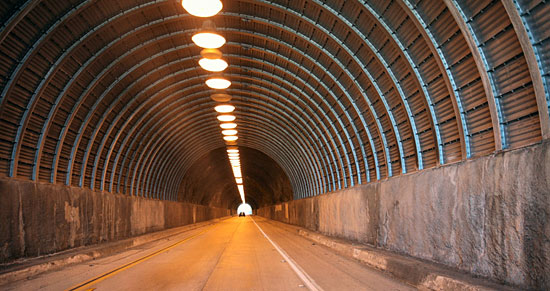

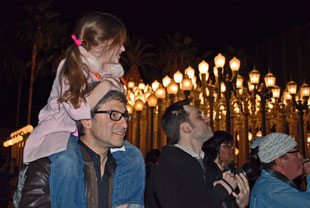

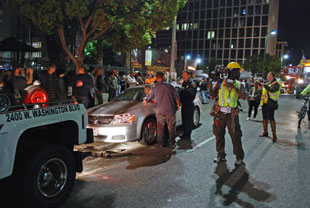
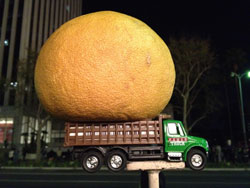
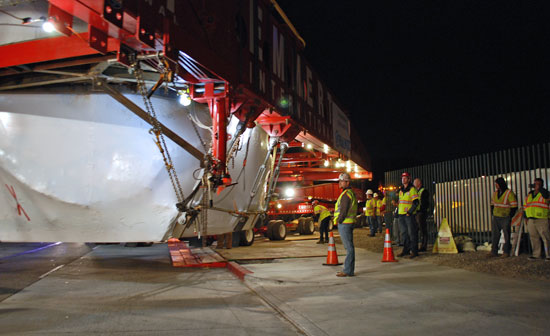






 Check for the latest closure information
Check for the latest closure information








